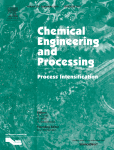
 A paper by Matthew S. WALTERS, Thomas F. EDGAR, Gary T. ROCHELLE was published today in Chemical Engineering and Processing. In their work the team at the University of Texas at Austin used an advanced thermodynamic model, developed in Aspen Properties, relying on previous extensive data acquisition and regression, within the model of a CO2 absorber column developed in gPROMS.
A paper by Matthew S. WALTERS, Thomas F. EDGAR, Gary T. ROCHELLE was published today in Chemical Engineering and Processing. In their work the team at the University of Texas at Austin used an advanced thermodynamic model, developed in Aspen Properties, relying on previous extensive data acquisition and regression, within the model of a CO2 absorber column developed in gPROMS.
The team reported some issues with the implementations of CAPE-OPEN, mainly different representations of species in Aspen Properties and gPROMS (true against apparent approach respectively) and also a lack of analytical derivatives being handled, Another side effect of CAPE-OPEN was the large number of algebraic variables (more than 20000) to be manipulated because CAPE-OPEN relies on the entire list of compounds at any time, whatever the actual presence of compounds.
Anyhow the model represents an improvement compared to previously published dynamic rate-based dynamic models of a CO2 absorber column. In particular CAPE-OPEN proved useful in leveraging on previous work that would have been difficult if not impossible to transfer within gPROMS.
It may be worth noting that one of the first examples of CAPE-OPEN usage was already a CO2 absorber column, a steady-state one, where the rate-based model of the column was developed in gPROMS and the thermodynamic model was from Aspen Properties.
